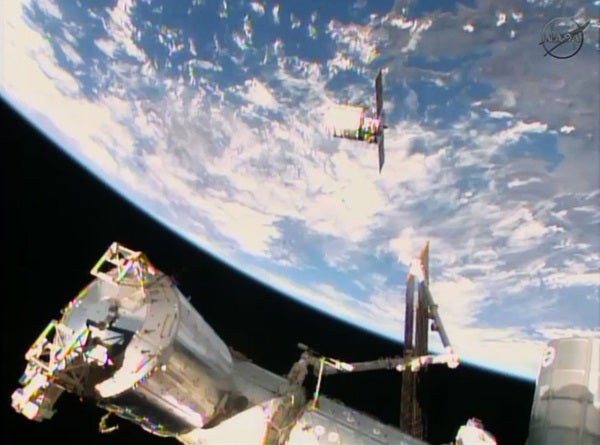Japanese astronaut Koichi Wakata commanded the station’s robotic arm to guide Cygnus to the Earth-facing port of the Harmony node and berthed it at 8:05 a.m. Expedition 38 Flight Engineer Rick Mastracchio then led the effort to get Cygnus bolted and latched to Harmony’s common berthing mechanism.
After the new commercial cargo craft was attached to Harmony, Wakata began leak checks in the vestibule, or the area between the docked vehicle and the space station. Working well ahead of schedule, Hopkins and Mastracchio opened the hatch to the Cygnus cargo craft at 12:17 p.m., beginning five weeks of cargo transfer activities.
All three astronauts monitored the approach and rendezvous of Cygnus from inside the cupola. The trio was at the robotics workstation looking out the cupola’s seven windows, observing video display monitors and checking real-time data.
The Antares rocket carrying the Cygnus resupply craft launched January 9 at 1:07 p.m. from Wallops Flight Facility in Virginia and reached orbit 10 minutes later. Cygnus arrived on time at the station despite solar flux activity delaying its launch one day. The increased radiation from the solar flares could potentially have affected the spacecraft’s avionics. Flight controllers reported the six station residents were safe during the solar event that occurred last Tuesday.
Mission controllers from Orbital Sciences guided Cygnus toward the station during its three-day trip. Once Cygnus came within range of the station, Houston and Japanese mission controllers began joint operations with Orbital Sciences. NASA tracked the vehicle during its final approach. The Japan Aerospace Exploration Agency supported Cygnus’ final rendezvous with the station using the Kibo laboratory’s rendezvous gear.
The Cygnus cargo vehicle consists of two modules. The service module provides attitude control, propulsion, navigation, electrical power, and contains the solar arrays. The pressurized cargo module, which makes up the majority of the vehicle, provides the space for delivering cargo and logistics. However, there is no capacity for the recovery of cargo as the vehicle is intended for a destructive reentry over the Pacific Ocean on February 19. It will be unberthed and released from the station February 18.
Orbital Sciences conducted a demonstration mission in September when its first Cygnus commercial resupply craft arrived at the station September 29. The Cygnus delivered 1,300 pounds (590 kilograms) of noncritical gear, then was reloaded with trash and left the station October 22 for a fiery destruction over the Pacific Ocean.










